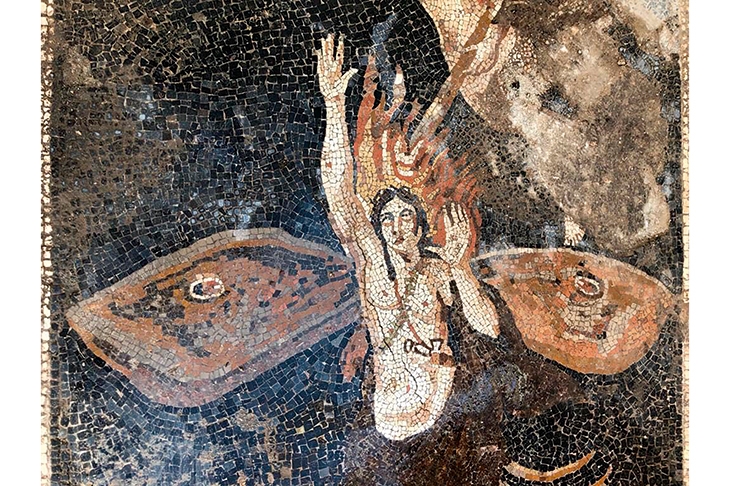One afternoon in AD 79 an unusual cloud appeared above Vesuvius in the Bay of Naples. ‘It was raised high on a kind of very tall trunk,’ recalled Pliny the Younger, likening it to an umbrella pine tree, ‘and spread out into branches.’ When, finally, the cloud collapsed and the sky grew dark, some people raised their hands to the gods. Others reasoned that ‘there were now no gods anywhere and that the night would last for ever and ever across the universe’.
There are corners of the ancient cities that have not seen daylight since they were buried in volcanic debris. While excavations officially began in Pompeii and Herculaneum in the mid 18th century, there remains much to uncover, and still more to restore. Next month, an exhibition dedicated to the Villa dei Papiri in Herculaneum will open at the Getty Villa in LA. Recent finds will be displayed alongside newly analysed treasures including a celebrated bronze ‘Drunken Satyr’. Meanwhile in Pompeii, the shoring up and conservation of the area known as Regio V, in the north of the city, as part of the €105 million Great Pompeii Project, is unearthing some extraordinary works of art.
The discovery of a scrawled note in the so-called House of the Garden, where a beautiful fresco of Venus and Cupid was also found, has even reopened the debate about when exactly Vesuvius erupted. ‘On 17 October,’ the charcoal graffito reads, ‘he ate too much food.’ Hardly poetry, but for the many archaeologists who believe that the eruption took place in October rather than 24 August — the date given in some manuscripts — it is catnip. Charcoal, after all, does not usually survive long.
The range of autumn fruits preserved in the layers has long roused suspicions over the timing of the eruption. Next to the carbonised seeds and frazzled skins of meals tragically left uneaten, the sensitive still lifes found in Regio V burst with colour. A peacock poses among the shrubbery in one wall painting. A long-tailed bird eyes some luscious figs and grapes on a shelf in another. A similar study, featuring a sparrow with fruit, was formerly found at Oplontis, just along from Pompeii.
Examining what remains of an ancient building can be like going Through the Keyhole. When you look at the art that is coming out of one villa in Regio V, in particular, you can’t help but ask yourself: who lived in a house like this? Priapus is weighing his penis in the hall, Leda is having sex with the swan in the bedroom, and Narcissus is enjoying his own reflection. Every household has its problems.
Often Narcissus is depicted alone, but in this wall painting he is joined by Cupid and a greyhound, and looks all the more self-absorbed for the company. The dog barks and reaches for his drapery, but Narcissus does not notice. You know he’d be only too pleased if the mutt disrobed him and exposed more of his flesh to himself.
The muscular Priapus, a popular figure in ancient homes, was invoked to ward off evil spirits and promote fertility. Leda did not need his help. Following her encounter with the swan — Jupiter in disguise — the Spartan queen produced an egg from which there hatched the beautiful Helen and Pollux. In a wall painting from Herculaneum she mates with the bird while standing. How much more comfortable she looks in the Pompeii picture as she receives him sitting down.
As in most ancient pictures, Jupiter’s transformation into the swan is complete. There is no suggestion in the painting that the change is still taking place. Mosaicists at the nearby House of Jupiter grappled far more ambitiously to illustrate metamorphosis in progress. Their newly uncovered floor design, which dates to the 2nd century BC, features a winged half-man, half-scorpion, his hair being set alight, hovering above a coiled snake. The director of the new excavations, Massimo Osanna, has identified the figure as the giant Orion, son of the sea god Neptune, being turned into a constellation.
According to one version of the myth, Orion boasted that he could kill all animals, so Earth sent a scorpion to kill him. The snake in the mosaic represents the earth from which they are rising. Orion sprouts wings as he is transformed, like a butterfly leaving its chrysalis. A second mosaic discovered in the House of Jupiter features a cluster of exotic creatures, including a crocodile, wolf, bear, gazelle and eagle. Could that be Orion, his left leg and arm alone preserved, rounding up with red ropes the animals he plans to slaughter?
The focus on Orion, as Professor Osanna has observed, reveals the influence of Egypt, especially Alexandria, where astronomy was widely studied. Other recent finds at Pompeii preserve evidence of distinctly Roman religious practices. A delicate lararium or shrine to the household gods is among the discoveries from the House of the Enchanted Garden. Beneath it is a magnificent painting featuring two large snakes, known as ‘Good Spirits’, slinking towards an altar that bears a pine cone and eggs. A real altar was found nearby.
It was typical of Pompeian artists to make paintings of objects that could be seen elsewhere in the house or garden. When excavators uncovered a large thermopolium or hot food bar in the city a few months ago, they found that one side of it bore a painting of the bar itself, with storage jars leaning against it. Propped up against the counter were real amphorae of the same type. How many people enjoyed their last lunch here before perishing beneath the volcano?
Pliny the Elder, uncle of the younger Pliny, lost his life at the coastal town of Stabiae, not far from Pompeii. He left behind a remarkable encyclopaedia in which he documented the peculiarities of the natural world. The central painting on the food stall features some of the phenomena he described. A mermaid-like nereid plays a lyre and rides a hippocampus or fish-tailed horse towards some dolphins. Pliny the Elder, who was inclined to believe in the existence of nereids and other fantastical creatures, had described the dolphin as ‘the very fastest of animals, not only of sea creatures, faster than a bird’. In the painting the dolphins dip and dive to the sound of the nereid’s music.
The art of Pompeii still sings where so many people were silenced. To gaze at pictures from their bedroom walls and tiles from their floors only now, almost 2,000 years after the volcano erupted, feels like the best kind of intrusion. Their world breathes again as the sunlight filters in.






Comments